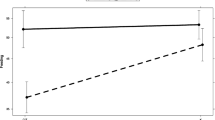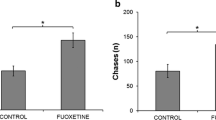Abstract
The present study examined the effects of the selective serotonin reuptake inhibitor, fluoxetine, on the behavior of female Siamese fighting fish, Betta splendens, in three different boldness assays (Empty Tank, Novel Environment, Social Tendency). When females were unexposed to fluoxetine, boldness was consistent within a context and correlated across assays. Fluoxetine exposure affected behavior within and among individuals on multiple levels. Exposure reduced overall boldness levels, made females behave in a less consistent manner, and significantly reduced correlations over time and across contexts. Fluoxetine exerted its effects on female Betta splendens behavior in a dose-dependent fashion and these effects persisted even after females were housed in clean water. If fluoxetine exposure impacts behaviors such as exploration that are necessary to an individual’s success, this may yield evolutionary consequences. In conclusion, the results show that fluoxetine exposure alters behavior beyond the level of overall response and highlights the importance of studying the behavioral effects of inadvertent pharmaceutical exposure in multiple contexts and with different dosing regimes.

Similar content being viewed by others
References
Arnold KE, Boxall ABA, Brown AR, Cuthbert RJ, Gaw S, Hutchinson TH et al (2013) Assessing the exposure risk and impacts of pharmaceuticals in the environment on individuals and ecosystems. Biol Lett 9:20130492
Asendorf JB (1990) The measurement of individual consistency. Methodika 4:1–23
Barnes KK, Kolpin DW, Furlong ET, Zaugg SD, Meyer MT, Barber LB (2008) A national reconnaissance of pharmaceuticals and other organic wastewater contaminants in the United States. 1. Groundwater. Sci Tot Environ 402:192–200
Barry MJ (2013) Effects of fluoxetine on swimming and behavioral responses of the Arabian killifish. Ecotoxicology 22:425–432
Bell AM (2007) Future directions in behavioral syndromes research. Proc R Soc Lond B 275:755–761
Blair BD, Crago JP, Hedman CJ, Klaper R (2013) Pharmaceutical and personal care products found in the great lakes above concentrations of environmental concern. Chemosphere 93:2116–2123
Boake CRB (1989) Repeatability: its role in evolutionary studies of mating behavior. Evol Ecol 3:173–182
Briffa M, Sneddon LU, Wilson AJ (2015) Animal personality as a cause and consequence of contest behavior. Biol Lett 11:20141007
Brooks BW (2014) Fish on Prozac (and Zoloft): ten years later. Aquat Toxicol 151:61–67
Budaev SV (2010) Using principal components and factor analysis in animal behavior research: caveats and guidelines. Ethology 116:472–480
Clements S, Schreck CB (2007) Chronic administration of fluoxetine alters locomotor behavior, but does not potentiate the locomotor stimulating effects of CRH in juvenile Chinook salmon (Oncorhynchus tshawytscha). Comp Biochem Physiol A 147:43–49
Clotfelter ED, Rodriguez AC (2006) Behavioral changes in fish exposed to phytoestrogens. Environ Poll 144:833–839
Cockrem J (2007) Stress, corticosterone responses and avian personalities. J Ornithol 148:169–178
Coppens CM, de Boer SF, Koolhaas JM (2010) Coping styles and behavioral flexibility: towards underlying mechanisms. Phil Trans Lond B 365:4021–4028
De Lange HJ, Noordoven R, Murk AJ, Lürling M, Peeters ETHM (2006) Behavioral responses of Gammarus pulex (Crustacea, Amphipoda) to low concentrations of pharmaceuticals. Aquat Toxicol 78:209–216
De Pedro N, Pinillos ML, Valenciano AI, Alonso-Bedate M, Delgado MJ (1998) Inhibitory effect of serotonin on feeding behavior in goldfish: involvement of CRF. Peptides 19:505–511
Decker RA, Griffen BD (2012) Correlating context-specific boldness and physiological condition of female sand fiddler crabs (Uca pugilator). J Ethol 30:403–412
Di Poi C, Bidel F, Dickel L, Bellanger C (2014) Cryptic and biochemical responses of young cuttlefish Sepia officinalis exposed to environmentally relevant concentrations of fluoxetine. Aquat Toxicol 151:36–45
Dingemanse NJ, Reale D (2005) Natural selection and animal personality. Behaviour 142:1159–1184
Ducrest AL, Keller L, Roulin A (2008) Pleiotropy in the melanocortin system, coloration and behavioral syndromes. Tren Ecol Evol 23:502–510
Dzieweczynski TL, Hebert OL (2013) The effects of short-term exposure to an endocrine disrupter on behavioral consistency in juvenile and adult male Siamese fighting fish. Arch Environ Contamin Toxicol 64:316–326
Dzieweczynski TL, Campbell BA, Marks JM, Logan B (2014) Acute exposure to 17α-ethinylestradiol alters boldness behavioral syndrome in female Siamese fighting fish. Horm Behav 66:577–584
Egan RJ, Bergner CL, Hart PC, Cachat JM, Canavello PR, Elegante MF et al (2009) Understanding behavioural and physiological phenotypes of stress and anxiety in zebrafish. Behav Brain Res 205:38–44
Falconer DS, Mackay TFC (1996) Introduction to quantitative genetics, 4th edn. Pearson Prentice Hall, Harlow
Fent K, Westron AA, Caminada D (2006) Ecotoxicology of human pharmaceuticals. Aquat Toxicol 76:122–159
Gaworecki KM, Klaine SJ (2008) Behavioral and biochemical responses of hybrid striped bass during and after fluoxetine exposure. Aquat Toxicol 88:207–213
Griffin LD, Mellon SH (1999) Selective serotonin reuptake inhibitors directly alter activity of neurosteroidogenic enzymes. Proc Natl Acad Sci USA 96:13512–13517
Guler Y, Ford AT (2010) Anti-depressants make amphipods see the light. Aquat Toxicol 99:397–404
Hazelton PD, Du B, Haddad SP, Fritts AK, Chambliss CK, Brooks BW, Bringolf RB (2014) Chronic fluoxetine exposure alters movement and burrowing in adult freshwater mussels. Aquat Toxicol 151:27–35
Hebert OL, Lavin LE, Marks JM, Dzieweczynski TL (2014) The effects of 17α-ethinylestradiol on boldness and its relationship to decision-making in male Siamese fighting fish. Anim Behav 87:203–212
Invernizzi R, Bramante M, Samanin R (1996) Role of 5-HT1A receptors in the effects of acute and chronic fluoxetine on extracellular serotonin in the frontal cortex. Pharmacol Biochem Behav 54:143–147
Jones KA, Godin JGJ (2010) Are fast explorers slow reactors? Linking personality type and anti-predator behavior. Proc R Soc B 277:625–632
Khan IA, Thomas P (1992) Stimulatory effects of serotonin on maturational gonadotropin release in the Atlantic croaker Micropogonias undulates. Gen Comp Endocrinol 88:388–396
Kohlert JG, Mangan BP, Kodra C, Drako L, Long E, Simpson H (2012) Decreased aggressive and locomotor behaviors in Betta splendens after exposure to fluoxetine. Psychol Rep 110:51–62
Kolpin DW, Furlong ET, Meyer MT, Thurman EM, Zaugg SD, Barber LB, Buxton HT (2002) Pharmaceuticals, hormones, and other organic wastewater contaminants in U.S. streams, 1999–2000: a national reconnaissance. Environ Sci Tech 36:1202–1211
Kostich MS, Lazorachak JM (2008) Risks to aquatic organisms posed by human pharmaceutical use. Sci Tot Environ 389:329–339
Kurvers R, Prins HHT, van Wieren SE, van Oers C, Nolet BA, Ydenberg RC (2010) The effect of personality on social foraging: shy barnacle geese scrounge more. Proc R Soc B 277:601–608
Lister A, Regan C, Van Zwol J, Van Der Kraak G (2009) Inhibition of egg production in zebrafish by fluoxetine and municipal effluents: a mechanistic evaluation. Aquat Toxicol 95:320–329
Lynn SE, Egar JM, Walker BG, Sperry TS, Ramenofsky M (2007) Fish on Prozac: a simple, noninvasive physiology laboratory investigating the mechanisms of aggressive behavior in Betta splendens. Adv Physiol Ed 31:353–363
Mennigen JA, Crump K, Xiong H, Zhao E, Popesku P, Anisman H, Xiz X, Trudeau VL (2008) The effects of fluoxetine on the reproductive axis of female goldfish (Carrasius auratus). Physiol Gen 35:273–282
Metcalfe CD, Chu S, Judt C, Li H, Oakes KD, Servos MR, Andrews DM (2003) Antidepressants and their metabolites in municipal wastewater, and downstream exposure in an urban watershed. Environ Sci Chem 29:79–89
Muneoka K, Shirayama Y, Takigawa M, Shioda S (2009) Brain region-specific effects of short-term treatment with duloxetine, venlafaxine milnacipran and sertaline on monoamine metabolism in rats. Neurochem Res 34:542–555
Nakagawa S, Schielzeth H (2010) Repeatability for Gaussian and non-Gaussian data: a practical guide for biologists. Biol Rev 85:935–956
Olsén KH, Ask K, Olsén H, Porsch-Hällström I, Hallgren S (2014) Effects of the SSRI citalopram on behaviors connected to stress and reproduction in Endler guppy, Poecilia wingei. Aquat Toxicol 148:113–121
Oswald ME, Drew RE, Racine M, Murdoch GK, Robison BD (2013) Is behavioral variation along the bold-shy continuum associated with variation in the stress axis in zebrafish? Physiol Biochem Zool 85:718–728
Perreault HAN, Semsar K, Godwin J (2003) Fluoxetine treatment decreases territorial aggression in a coral reef fish. Physiol Behav 79:719–724
Prieto MJ, Gutierrez HC, Arévalo RA, Chiaramoni NS, del Valle Alonso S (2012) Effect of risperodone and fluoxetine on the movement and neurochemical changes of zebrafish. J Med Chem 2:129–138
Schuett W, Dall SRX (2009) Sex differences, social context and personality in zebra finches, Taeniopygia guttata. Anim Behav 77:1041–1050
Sebastine IM, Wakeman RJ (2003) Consumption and environmental hazards of pharmaceutical substances in the UK. Proc Saf Environ Protect 81:229–235
Sih A, Bell AM, Johnson JC, Ziemba RE (2004) Behavioral syndromes: an integrative overview. Quart Rev Biol 79:241–277
Sinn DL, Apiolaza LA, Moltschaniwskyj NA (2006) Heritability and fitness-related consequences of squid personality traits. J Evol Biol 19:1437–1447
van Oers K, Klunder M, Drent PJ (2005) Context dependence of personalities: risk-taking behavior in a social and nonsocial situation. Behav Ecol 16:716–723
Weinberger J III, Klaper R (2014) Environmental concentrations of the selective serotonin reuptake inhibitor fluoxetine impact specific behaviors involved in reproduction, feeding and predator avoidance in the fish Pimephales promelas (fathead minnow). Aquat Toxicol 151:77–83
Wilson DS, Clark AB, Coleman K, Dearstyne T (1994) Shyness and boldness in humans and other animals. Tren Ecol Evol 9:442–446
Wilson ADM, Whattam EM, Bennet R, Visanuvimol L, Lauzon C, Bertram SM (2010) Behavioral correlations across activity, mating, exploration, aggression, and antipredator contexts in the European house cricket, Acheta domesticus. Behav Ecol Sociobiol 64:703–715
Winder VL, Pennington PL, Hurd MW, Wirth EF (2012) Fluoxetine effects on sheepshead minnow (Cyprinodon variegatus) locomotor activity. J Environ Health 47:51–58
Acknowledgments
The authors thank Brittney Logan for her assistance with data collection and fish care. They also thank Tori Doty, Nicole Greaney, Krystal Mannion, and Jodi Marks for their helpful feedback on an earlier version of this manuscript. Woon Yuen Koh provided statistical assistance. This work was funded by a University of New England Sponsored Programs grant to TLD (Grant # PDZ2).
Author information
Authors and Affiliations
Corresponding author
Ethics declarations
Conflict of interest
The authors declare that they have no conflicts of interest.
Rights and permissions
About this article
Cite this article
Dzieweczynski, T.L., Kane, J.L., Campbell, B.A. et al. Fluoxetine exposure impacts boldness in female Siamese fighting fish, Betta splendens . Ecotoxicology 25, 69–79 (2016). https://doi.org/10.1007/s10646-015-1568-8
Accepted:
Published:
Issue Date:
DOI: https://doi.org/10.1007/s10646-015-1568-8




